Across the Big Blue Pacific
Leaving Puerto Vallarta took a bit of coordinating but we sailed on the 18th of March, as planned. After jumping through immigration hoops on a Saturday, which is usually not an option, & topping off our fuel we got underway with wind enough to fill our sails. We took off on a pleasant starboard tack. Wahoo! 3,000 nautical miles away lay our destination: the Marquesas Islands of French Polynesia.
Ask any sailor and they will tell you how they wait with baited breath for that moment when the engine can go silent so all that is heard is the sound of water slapping the hull as the boat slips along through the sea. For our first few hours this was our reality. We were so thrilled. Unfortunately this was not to last for long. As the breezes fell away they took with them our initial enthusiasm. These light winds would carry us through the 2nd and 3rd day. Zero to low wind speeds we were going nowhere fast.
Moving extremely slow with barely enough wind to keep the sails from flogging captain Chris and I took our chance to dive in for a quick swim in the warm (80 degree), blue waters found a couple of hundred miles offshore. Luckily we had made it that far. With the main centered and the genoa furled we literally swam circles around the boat as it bobbed in the water. It was also a great time to do a visual inspection of all boat things below the surface. Things were looking good save for some interesting little critters already growing on the hull.
In 2016 when I made my first blue water passage I discovered a favorite thing of mine I never could have imagined. Sailing between La Cruz and La Paz we stalled in between. While the captain made himself busy by inspecting the engine and rigging he noticed me looking at the water with a wanting gaze. "Go ahead and jump in", he said. I think I hit the water before he finished his sentence. There I was, 100+ nautical miles from land swimming in a body of water I could not see the bottom in, not for the lack of clarity but for the sheer depth of course.
There are moments in life where you really get a sense of how minuscule you are in comparison to the universe you find yourself existing in. This was one of those moments for me. Since that plunge I have made it a point to swim in each body of water I find myself in the middle of, more diligently when the water is warm. The next chance I had was on my first Pacific crossing but this time 1,000+ nm from land and in over 19,000 feet of depth. I kept telling myself to not look down in case the kraken was coming for me. I'd rather not know. Then there also was that one time I crossed the Atlantic, swimming very near the Azores, and now here I am back in the Pacific. The thrill of it never gets old.
By the evening on the 21st, day 4 & a Tuesday, we started feeling the wind build again. It kicked up to between 10 - 15 kt which was just enough to move us along at a decent pace. The weather forecast showed that we would be seeing 25+ knots by Thursday. With the direction we were going in relation to the direction the wind would be coming from we were super excited as it meant possibly ticking off some big miles. Averaging 125 nm a day is quite normal when seeing the winds we were to see. We had no idea that we would actually get closer to 160 nm in a 24 hour period. Considering we still had approximately 2,500 more nm to our destination we looking forward to the push.
The forecast didn't lie! Along with the 25 - 35 knots of wind out of the north pushing us at speeds up to 8, sometimes 9 knots and more, we also were met with a 2 meter swell. That's when things got real roley poley, and a lot more challenging. From moving around the boat to using the bathroom to cooking, not to mention getting dressed - all of the simplest things become way more difficult. You couldn't even open a cabinet without the risk of something flying out at you.
Often times in these conditions I feel myself a pinball being batted from one paddle to the other due to how the waves knock the boat around. It's one thing when there is some sort of detectable pattern like the ball heading for said paddle knowing it's to be kicked back into the game. However when the seas become confused it's a different story. During these times you really can't foresee from which direction the boat will take the next bump so there is no preemptive bracing for impact. Don't I have the bruises to show for it! It's during these times when expletives start flying across the boat along with bodies & other objects. And sometimes the waves thump so hard on the hull it sounds like you've hit something substantial. Try sleeping through that!
On day 8 at sea we reached 1000 nm which put us approximately 1/3 rd of the way to the Marquesas. Now seeing more consistent boat speeds of 5 - 7 knots the whole crew felt quite satisfied. That also meant no more swimming. I missed swimming! We did get our salt water fix though with regular dousings on the back deck. A simple tool like a stout bucket at the end of a line can bring quite the refreshing splash. This is how we all kept from getting too uncomfortable due to heat, humidity, and B.O.
The crew for this journey totaled 4 people which broke our shifts down to 3 hour watches and the 4th day one of us would actually have off for most of it. This kept us rotating through different times as well, keeping things interesting. I believe its unanimous that the sunrise and sunset shifts are the best, followed closely by the midnight to 3 shift for me since it's when the stars are at their brightest, everyone is sleeping, & the boat noise it to a minimum. It's as if I am all alone with the expanse of sea and stars. Many of these nights I would watch the bioluminescence sparkling in the wake and bow waves made by the boat. It was even more amazing under the dark of the new moon. Twice I was visited by what I affectionately refer to as glitter torpedos - dolphins! First you hear the blow of their breathing and then their movement as they surf along beside the boat. And, if on one of these nights filled with sparkling water.
Here are some of those lovely sunrises we had the privilege to take in. Photos just don’t do them justice.

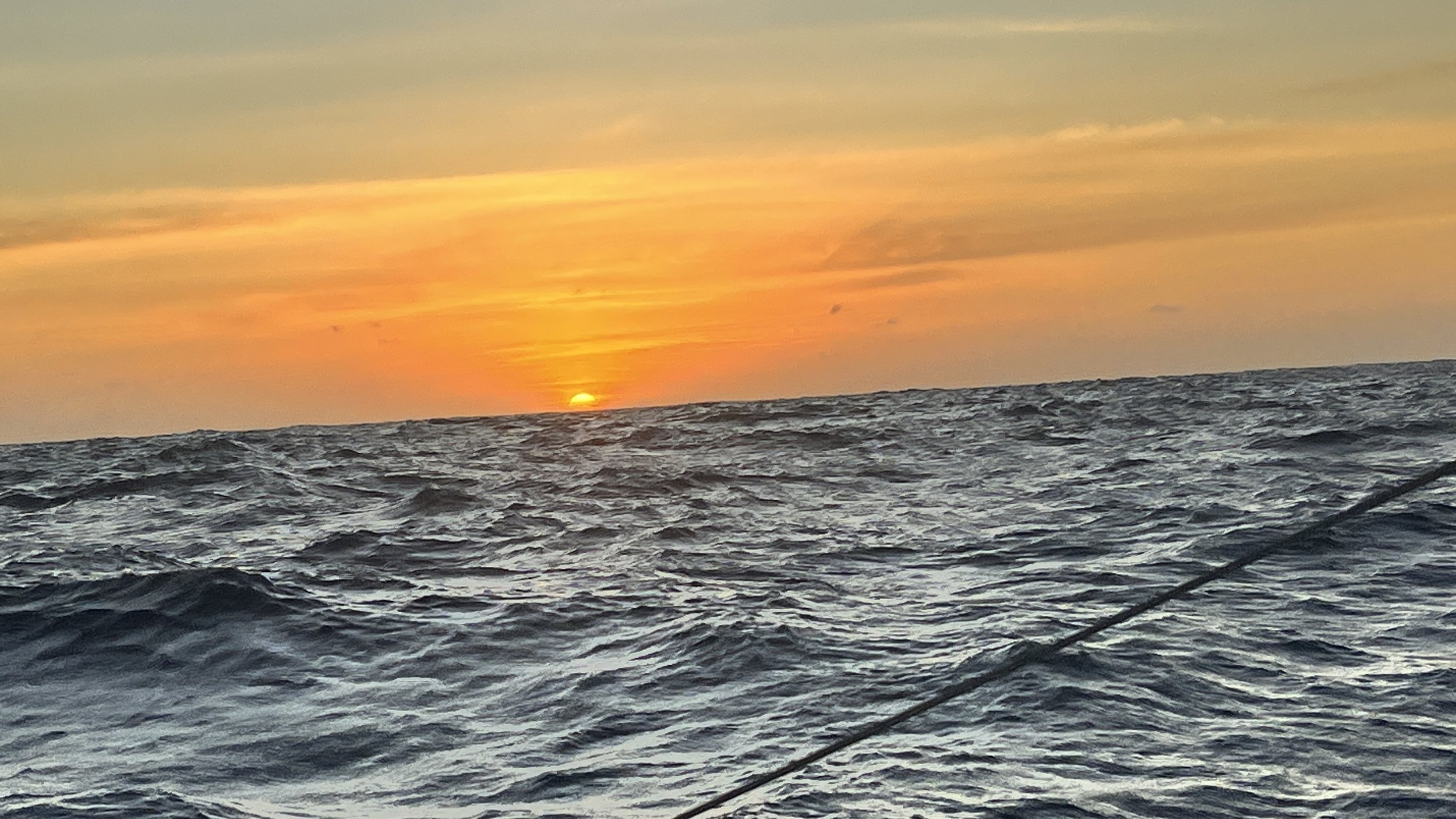
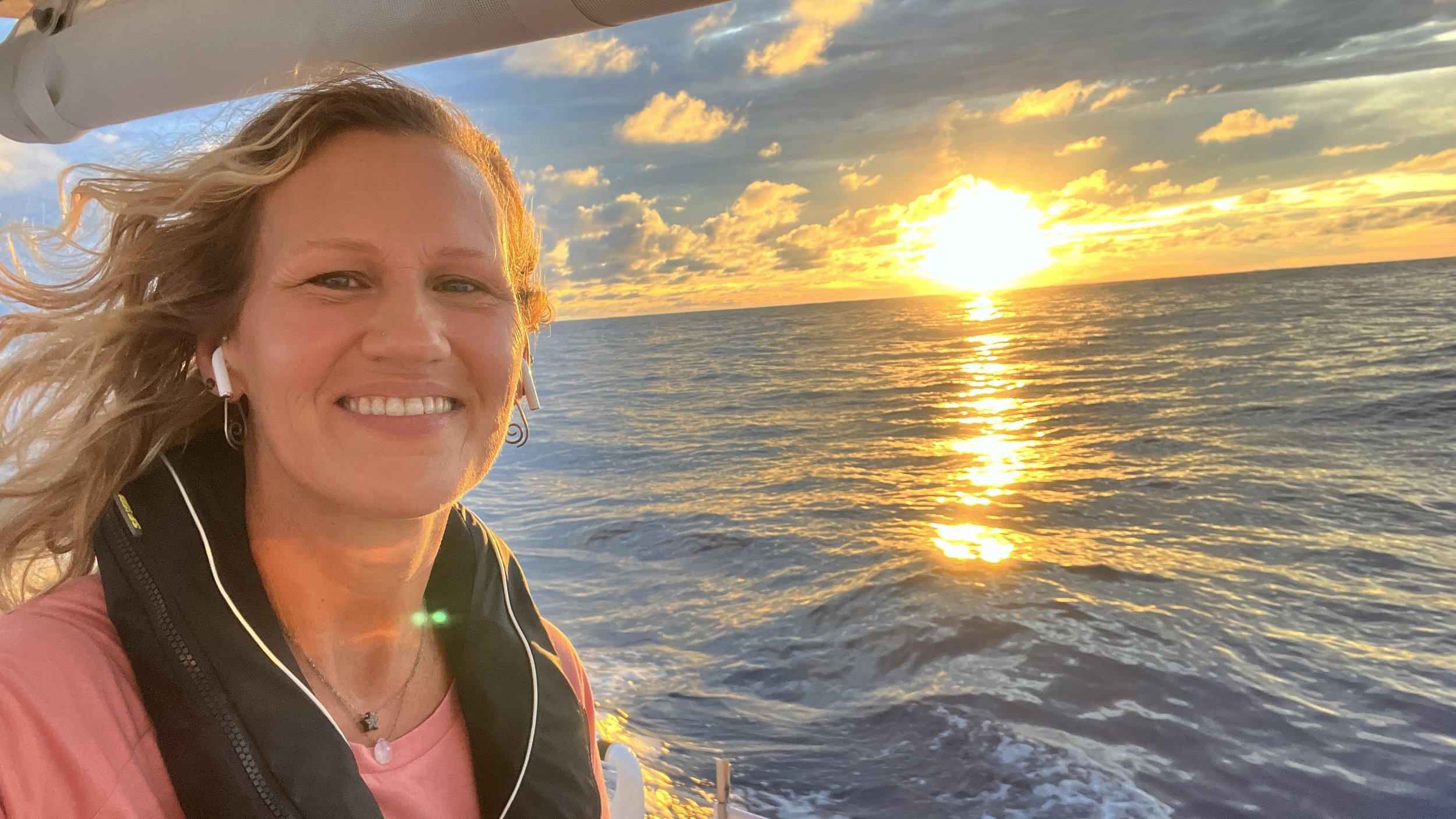
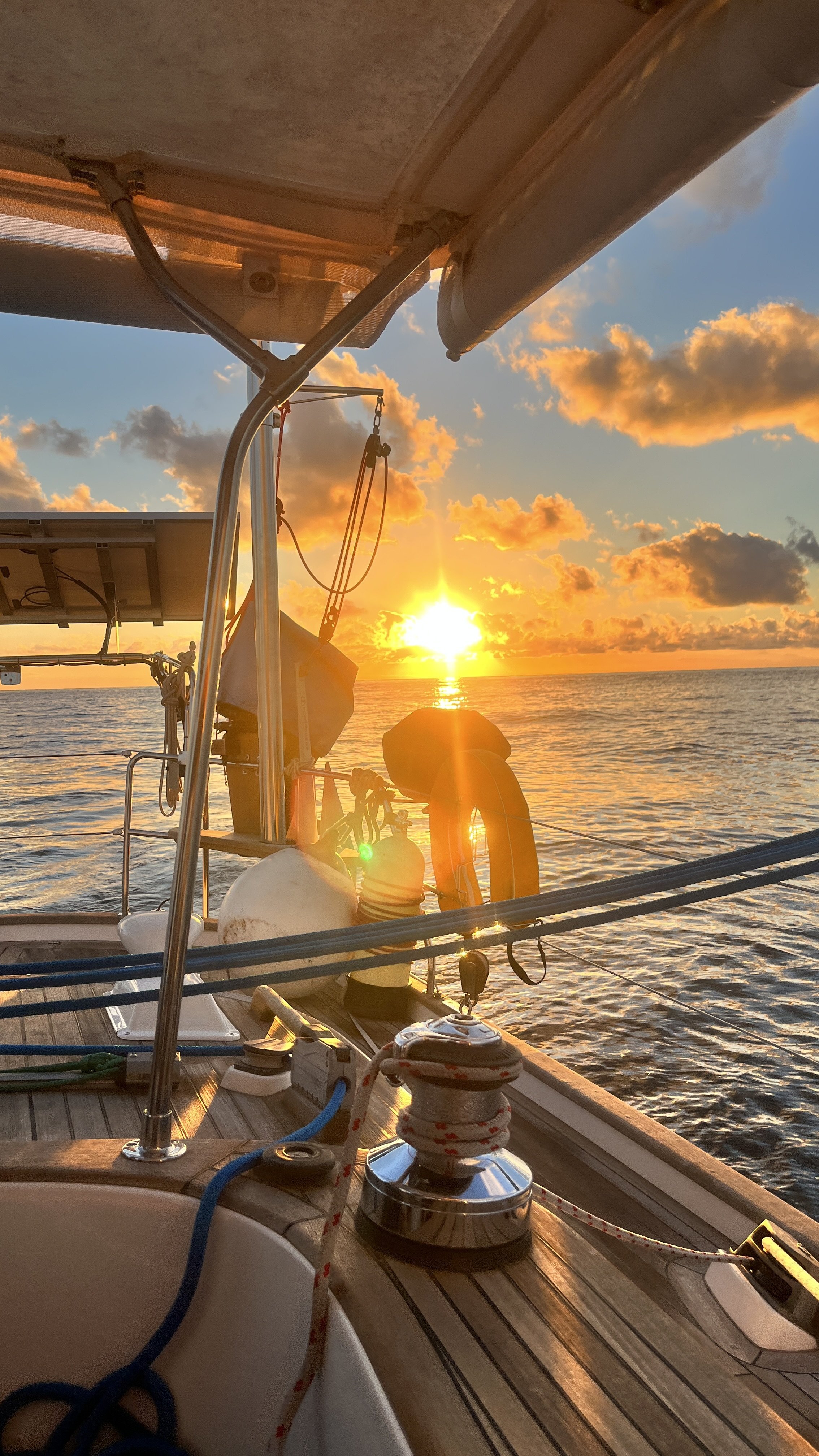
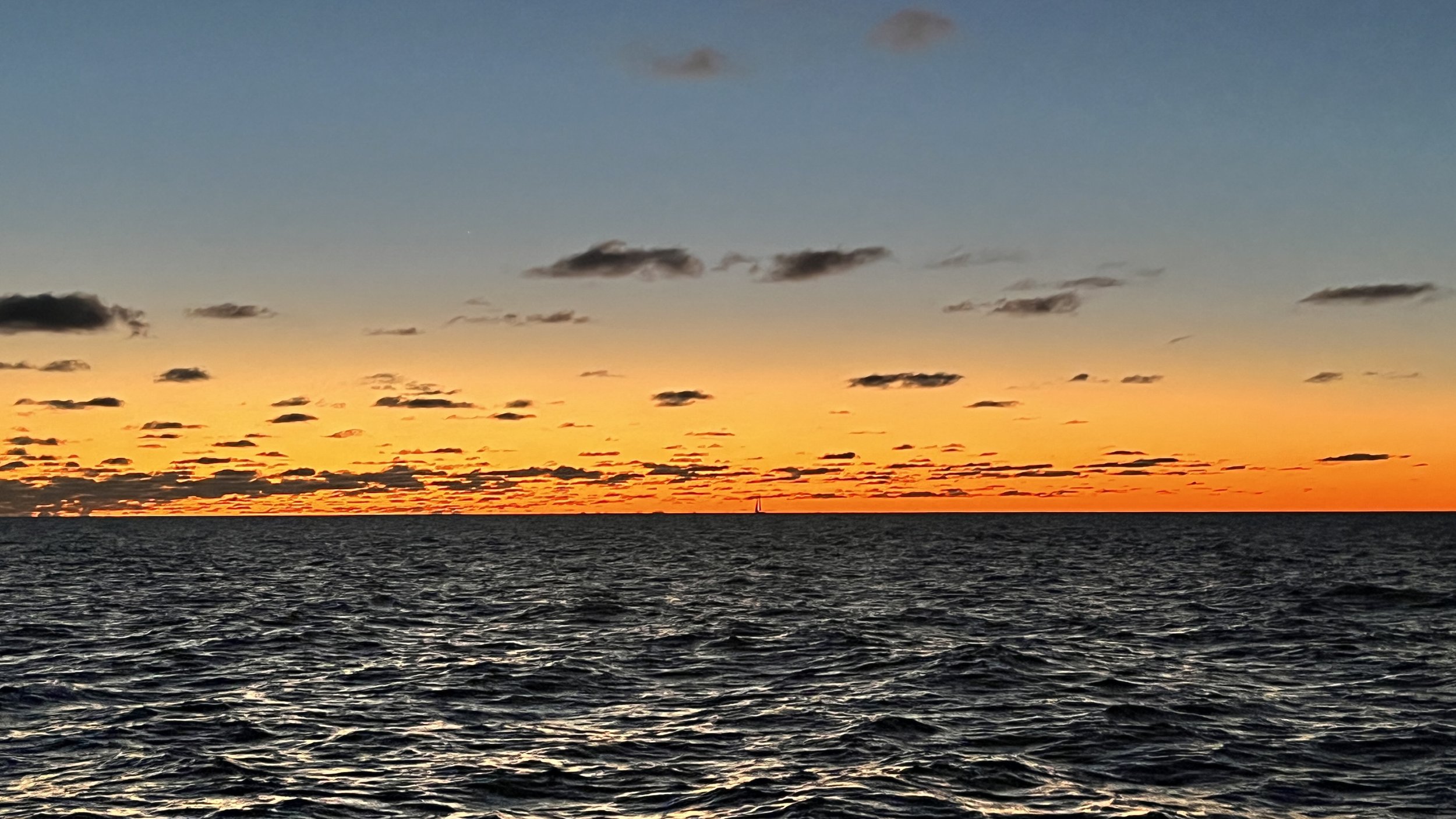
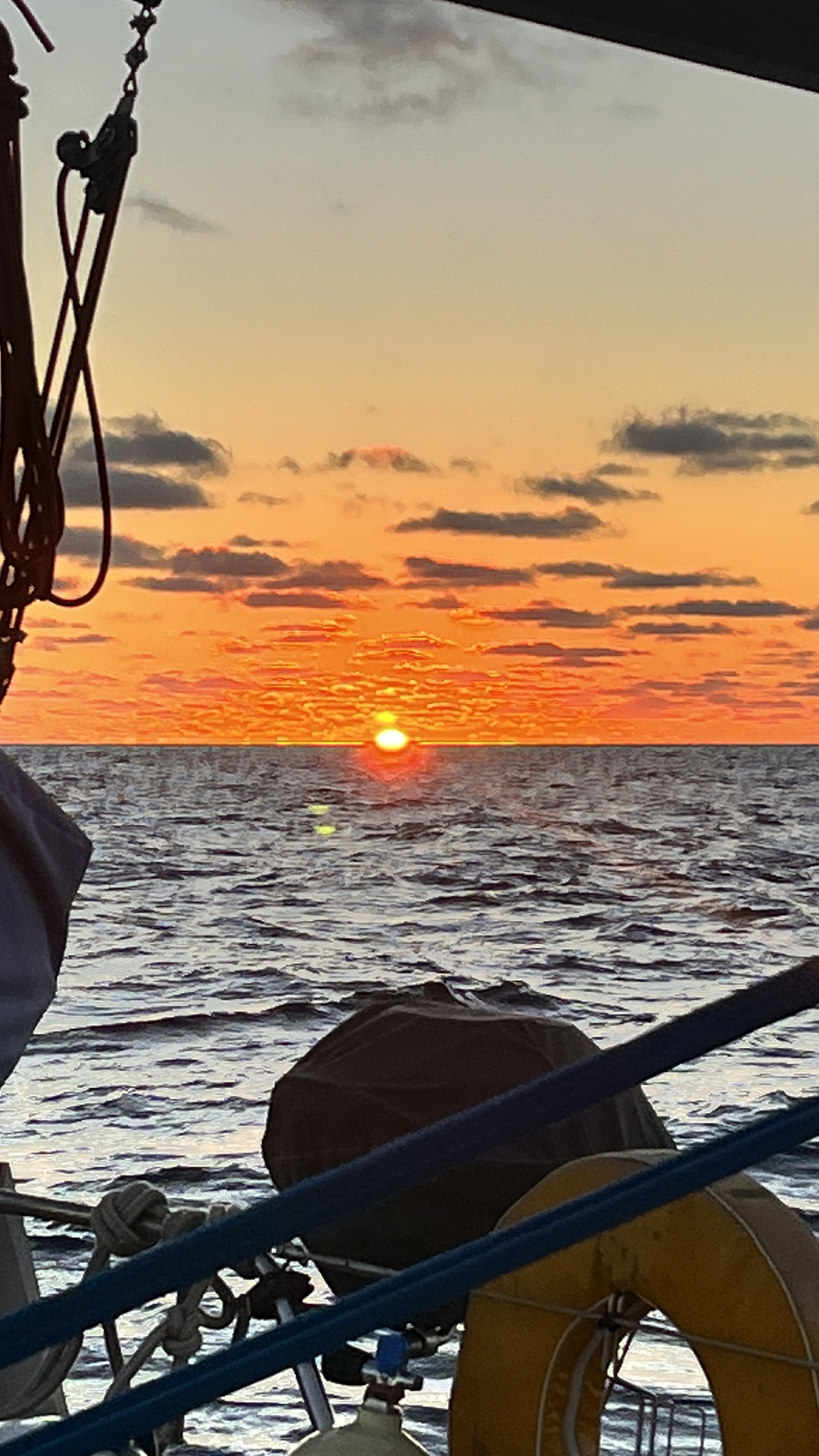
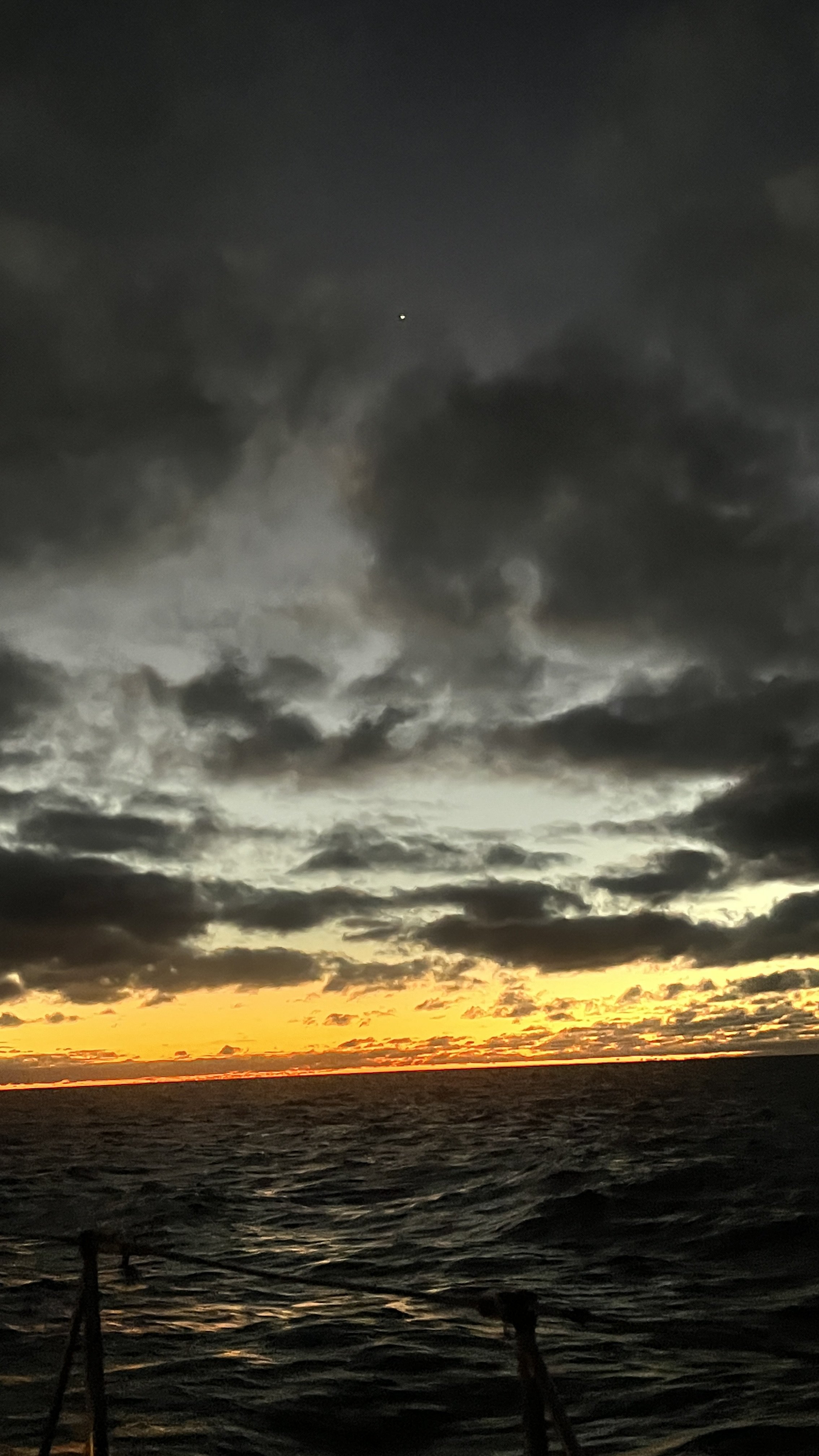
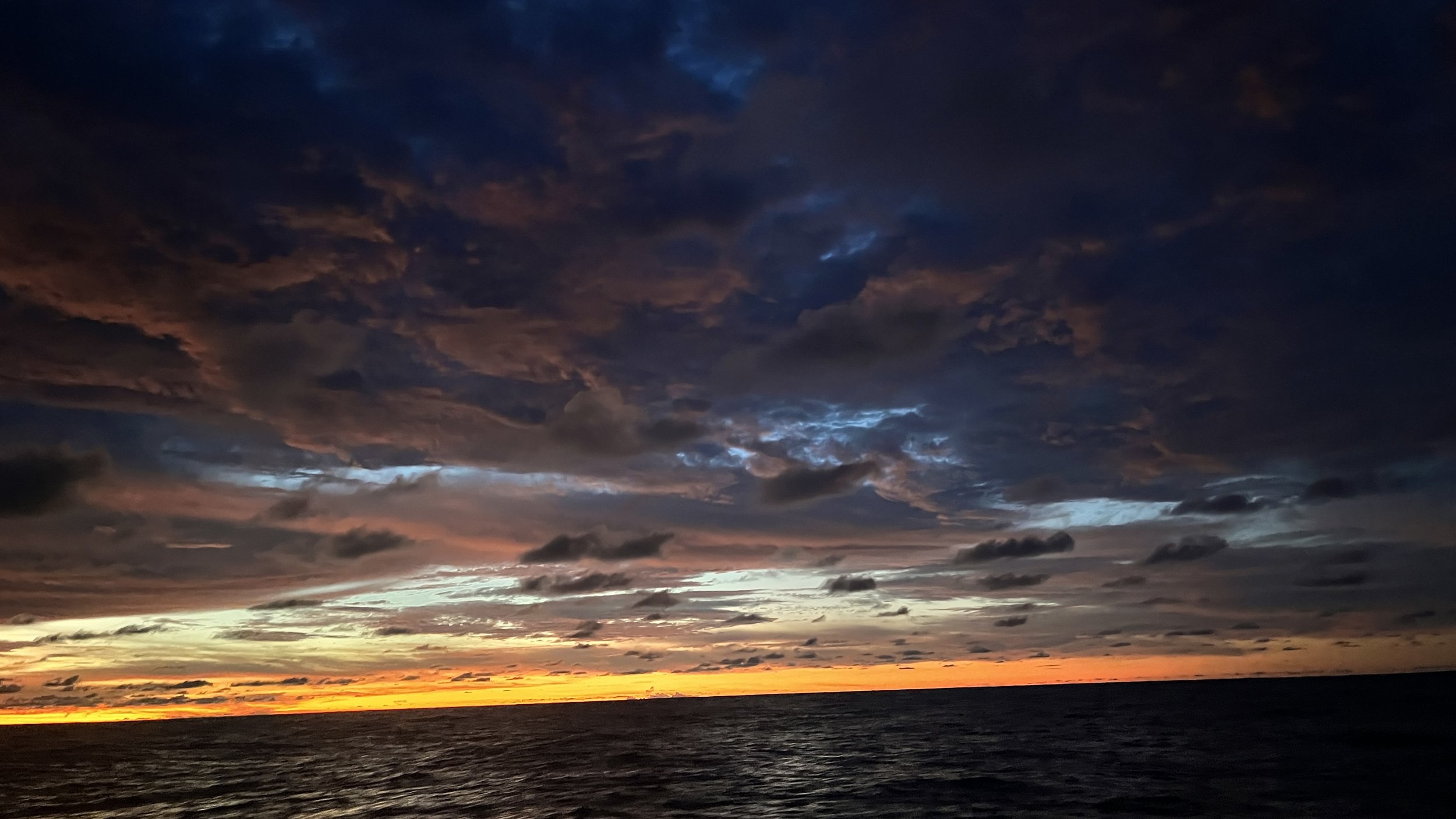
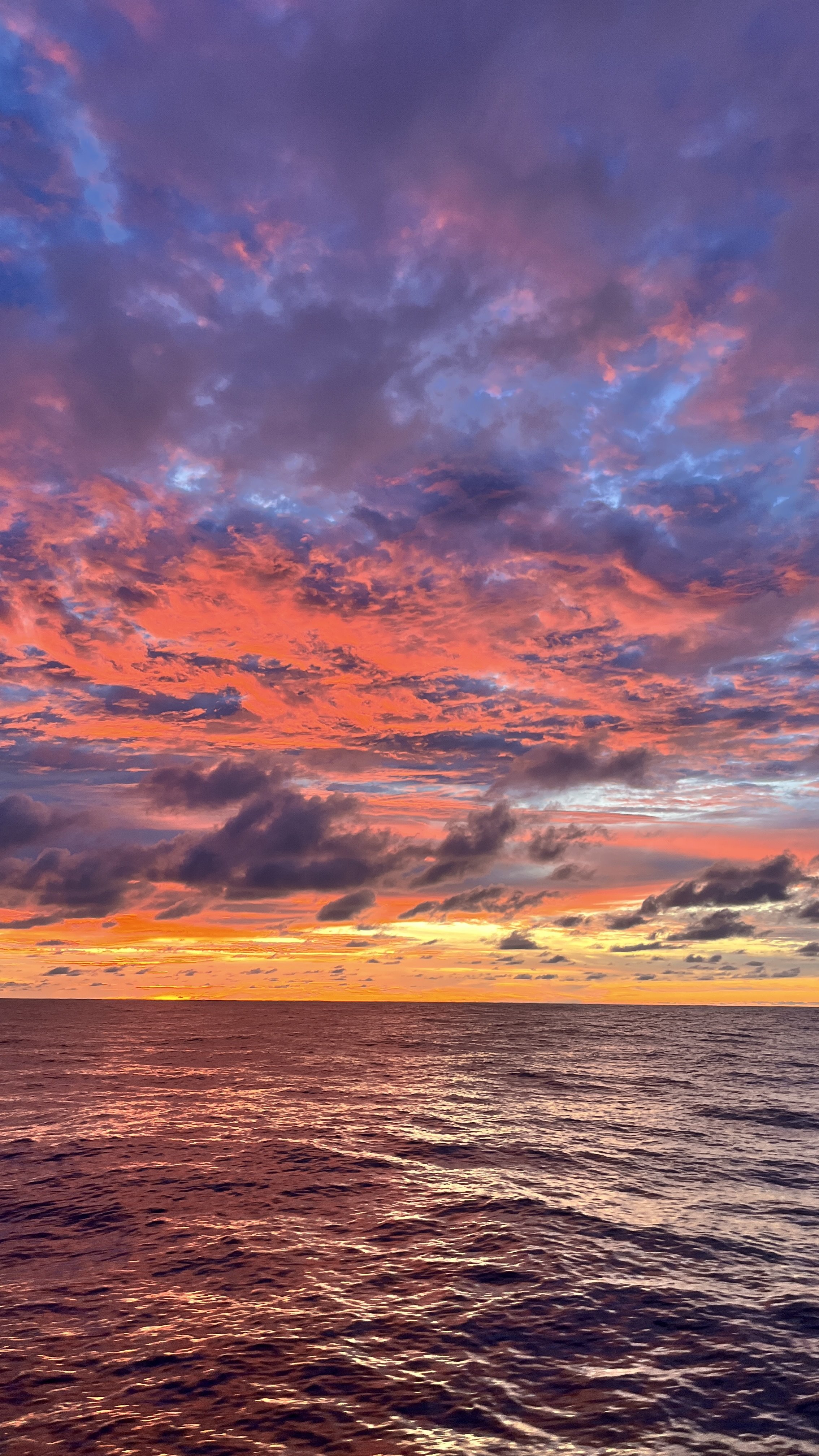
On March 31st at 11:34 am we crossed that imaginary line splitting the globe into North and South hemispheres. We went from Spring to Fall in the matter of mere feet. On crossing the equator the crew went from being pollywogs to proudly earning the title of shellbacks. Capitan Chris had already made this transition on a different voyage so he played the part of King Neptune, complete with aluminum foil crown and trident. We toasted our achievement, giving the first sip of champagne to the ocean to honor the true King Neptune, and completed our salute by blowing bubbles and drinking sparkling apple cider. I also left a tobacco offering in gratitude for the grace we had already experienced. It will be a moment forever cherished by me.
Now 14 days in we are over half way there. We are also in the middle of the ITCZ (Intertropical Convergence Zone), a zone extending 10 degrees on either side of the equator where one is more likely to see stormy weather on a regular, or nothing at all (aka the doldrums). Using PredictWind's offshore weather routing has helped us avoid both heavy weather and light winds. It's quite fascinating to see the ITCZ on a surface chart. You are able to literally spot the band of systems flowing above or below the equator seeing what to steer clear of. With this trend being so obvious we were given a trajectory to follow that had us sailing on in decent to great conditions.
April 1st: Yesterday was our first day of proper squalls. The first moment rain started to fall with any real volume we all jumped out from under the canopy, soap in hand, and took a group shower. Men stayed on the back while I sat under the boom. The main sail captured more rain and offered me a more powerful deluge for my bath. Sopping wet I couldn’t have felt more refreshed. Even the boat seemed to enjoy being salt free and squeaky clean.
Over the night we met with one squall after another. Since temperatures have been ever increasing as we’ve gotten closer to the equator the coolness that came with the rain was a relief. The winds, however, kept decreasing. Eventually we were literally bobbing around with zero kts of boat speed. Considering some squalls come with super high winds that can catch boats unaware with sails fully up and cause damage we felt lucky to have the opposite be true. At some point, with sails flogging and no wind expected we furled in both sails and, for the first time in almost two week, kicked on the motor. With this we got the batteries back up into a high state of charge and made our way a little quicker through the squalls that were lighting up the radar. By morning the wind had still not filled in but the rain had gone. Cloudy skies made for a stunning sunrise. At around noon the breezes began to pick up enough to shut down the motor. Once again we were sailing quietly along.
Today, April 3rd, we are down to 600 nm to go. This marks the 17th day at sea, and is officially the longest time I've personally been offshore. We've sailed through another bout of stronger winds and confused seas recently however now we are moving along on a beam reach with 10-15 kt winds and maybe a meter of swell off our port quarter. This gives us some surfing practice. Chris keeps an eye on the speed gauge waiting for the thus far elusive 10 kts of boat speed.
Some of the funnier experiences we've had on this sail include a flying fish jumping in through the salon hatch, landing at my feet and flopping around. This brought out a shocked squeal from me. Captain Chris to the rescue. He picked up the poor fish and attempted to launch it back into the water. Unfortunately for the fish it first bounced off a vent then landed on the deck, unbeknownst to us, where it met with an untimely death. Another was when a sea bird attempted to use our solar panel as a perch for the night. The panel was positioned horizontally to catch the mid day sun. As soon as the webbed feet touched down on the slick surface it proceeded to skate right off and land with a plop back into the water. Think Keystone cops sort of humor. We repositioned the panel so there was the invitation of the edge for the sweet bird to rest for the night. After many attempted approaches our fine feathered friend gave up. On the bright side this kept us for having to clean bird poop off the panel for the second time. Earlier in the voyage we did have one of these seafaring birds hang out on this particular perch for a whole night. In the morning we were gifted a find piece of shitty art work to clean up once it decided it had rested enough.
Today is April 6th. We have 112 nautical miles left until we reach our waypoint at the tip of Hiva Oa. There's a wager going as to how soon we will be able to see land. Hiva Oa claims mountains that rise 3,000+ feet above sea level. My guess is that we will see them 75 nm out. With the rest of the crew choosing 100, 90, & 50 we are keeping a keen look out.
We are due to arrive Friday, tomorrow, mid-day unless the winds decide to disappear on us, touch teak. Normally what would occur is we would head directly to the gendarmerie (French authorities) to see to the formalities of checking into the country and officially begin our 90 day count down in French Polynesia. This being Easter weekend, no can do. It's a four day holiday weekend putting our first possible check in on Tuesday. With hope this will allow us 4 more days to explore the islands included here in French Polynesia; Marquesas, Tuamotu, Gambier, Societies (Tahiti), Australs.
Currently the rough agenda has us in Hiva Oa long enough to check in, explore, refuel, grab more fresh veggies & fruit, do laundry, etc., etc., etc. Being that this land it not know for its fertile farms were one can harvest tons of veggies it's been rumored that you might, might, be able to buy a head of broccoli for $24! Yeah, I don't foresee that happening. Luckily for us we provisioned well, made good choices for heartier veggies, made good time, and followed suggestions from other cruisers how to make what fresh veg we have on board last longer. This has given us fresh options that have lasted up until now so we are not so starved that we would be inclined to pay that $24.
As for the fruit, that will be a different story for me. I am looking forward to fresh coconut water, papaya, rambuton (lychee), and whatever else I might find.
When first we jumped off the coast of Mexico we were guessing 25-35 days to landfall, depending oh how we were met in the doldrums & the ITCZ. It's taken us 20 days & a wake up!!! Bird Song is a speedy, nimble boat with new sails. Along with helpful weather routing we've been so fortunate. Two of our 'buddy boats' that actually left a day or two before us were stuck in the doldrums and crossed the equator 4 days after us. We've been sending them better wind vibes in hopes they will get going and stay moving for the rest of the trip.
Over night on the April 6th the full moon peeked over our left shoulder lightening the way while the Southern Cross hung a little further forward keeping us company as we continued onward. It was a gorgeous night to be at sea. My night watch had me up and enjoying the view.
On watch again from 0600 - 0900 on 7 April, day 21 of our crossing we only had 20 nm to go. At 0734, where the cloudy sky met the horizon, I began to notice what looked like a solid outline. It was mixed with the clouds so I couldn't be sure. The moon was now in front and to our starboard, big and bright. If that wasn't beauty enough then the sun began to rise. With all the light I was certain I was seeing Hiva Oa. Immediately I went down to wake the captain and other crew so they could enjoy our first sighting of land as well. We sat back soaking in the fact that we had made it. It was emotional for me. For Chris this was a dream 3 years in the making, and his first major crossing both as a sailor and as captain so I imagine emotional for him as well.
Until next time, be well!
~ Cheryl